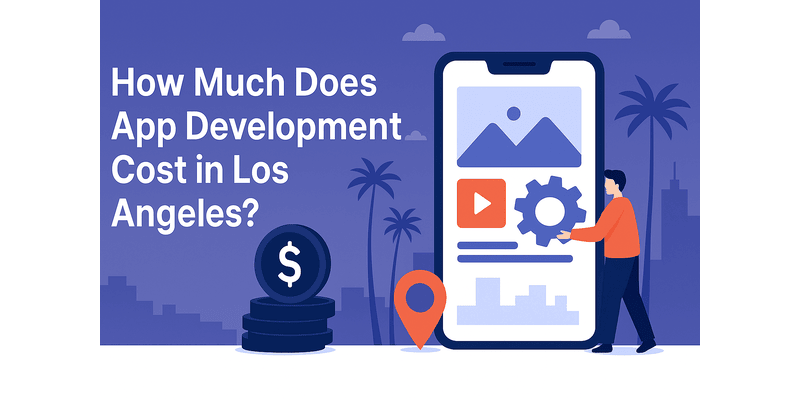Mobile applications have become vital tools for companies wishing to engage with their customers, automate services, and remain competitive. Whether an application is as straightforward as a booking app or as feature-rich as an eCommerce site, app development is composed of several factors that determine cost. One of the most common questions by company owners is, how much does app development cost in Los Angeles?
The cost isn't the same for everybody. The cost of developing an app is influenced by various important factors such as features, design, platform, and who does it. In this article, I will deconstruct the cost model, discuss what affects pricing, and assist you in knowing what to anticipate when your mobile app budget is concerned.
What Affects App Development Cost in Los Angeles?
App development cost varies greatly based on your project requirements. The following are the primary factors that determine cost:
1. App Complexity
Complexity of the app determines the cost. App complexity is usually categorized as three levels:
- Basic Apps
Apps with minimal functionality, minimal screens, and no live features fall in this category. Examples may include calculators, simple list apps, or static information apps. These are cheapest to develop.
- Mid-Level Apps
These include user logins, dashboards, API integrations, and a bit of real-time features such as messaging or location tracking. They include apps for service booking or basic eCommerce.
- Complex Apps
Apps with serious functionality such as live streaming, real-time data synchronization, AI integrations, or custom animations are in this category. They take heavy backend infrastructure and extensive testing, adding to the price.
2. Platform Selection
Your choice of platform contributes significantly to the cost of app development in Los Angeles.
You can develop for:
- Android alone
- iOS alone
- Both platforms individually (native)
- Both with a single codebase (cross-platform)
Developing with cross-platform tools such as React Native or Flutter will reduce your overall expense by enabling you to develop for both platforms simultaneously. This is suitable for startups or companies that require quick time-to-market.
3. Design and User Interface
Design is a significant driver of both cost and user experience. An easy-to-use, clean interface enhances user retention and happiness. Custom design effort, for example, individualized animations or personalized UX flows, can drive cost up, but it tends to perform better in the long term.
4. Key Features and Functionalities
More features equal more development time. Below are some typical features that affect cost:
- User authentication (sign-up, login)
- Push notifications
- In-app purchases
- GPS and location tracking
- Real-time chat
- Third-party API integrations
- Admin dashboard or CMS
Each of these features adds a level of coding, testing, and maintenance in the long run, which affects the overall cost.
5. Backend Infrastructure
There has to be a backend system to deal with data, users, and real-time operations. Development time and security planning go into creating a scalable backend. For apps that deal with significant data or real-time updates, the backend is potentially one of the most costly aspects.
Average App Development Cost in Los Angeles
Let's examine some cost ranges based on typical project sizes:
- Basic App: $10,000 – $25,000
- Mid-Level App: $25,000 – $70,000
- Complex App: $70,000 – $150,000+
These estimates might change depending on special needs and your development partner.
How to Keep the Cost of App Development in Los Angeles Affordable
Here are some tips to keep your budget under control while still creating a quality app:
1. Construct an MVP First
A Minimum Viable Product (MVP) contains only essential features sufficient to bring it to market. This method enables you to test your concept with real users prior to making a full-scale commitment. It also permits you to gather feedback and iterate on real usage.
2. Select Cross-Platform Development
If you want to target both Android and iOS users, consider using cross-platform frameworks. This helps reduce the app development cost in Los Angeles by cutting down on duplicate development time. It also speeds up the release process and makes updates easier to manage.
3. Prioritize High-Impact Features
Don't attempt to cram all the features you can into the initial release. Leave out what users really don't need, and reserve that for future revisions. Keeping development time brief and the expense lower keeps costs down.
4. Get the Right Team
Having a reputable Los Angeles app development company promotes transparency, quality, and improved ROI. Veteran teams prevent you from making mistakes that will jack up costs down the line.
Frequently Asked Questions Regarding App Development Cost in Los Angeles
Most businesses have several questions regarding timelines and secret costs before commencing. The following are two of the most common:
1. How long does it take to create an app?
- Simple apps: 1 to 2 months
- Medium apps: 3 to 6 months
- Complex apps: 6 months or more
The time then reflects directly on the overall cost as most developers charge for hours or project milestones.
2. Are there any hidden app development expenses?
While initial expenses are the most significant, there are also other expenses to factor in:
- App store fees
- Server hosting
- Updates and maintenance
- Marketing and support
Make sure to incorporate these in your long-term budgeting.
Why Local Matters: App Development in Los Angeles
Having a local team offers improved communications, the same time zones, and direct knowledge of your market. Most cross-platform app development companies these days have local teams and remote support, offering you flexibility at an affordable cost.
With local teams that are experienced in the California tech ecosystem, you receive improved information on user expectations and local compliance regulations.
Conclusion
There is no single answer to how much it costs to develop an app in Los Angeles. Prices depend on the features, technology, and complexity of customization needed. But knowing what drives prices up or down, selecting the appropriate development strategy, and prioritizing your most important features, you can get the best out of your investment.
If you’re planning to build an app, take time to explore your options, define your goals clearly, and work with a skilled team that aligns with your vision. With the right strategy, your mobile app can become a powerful tool for growth.






Comments